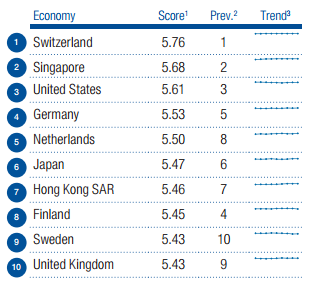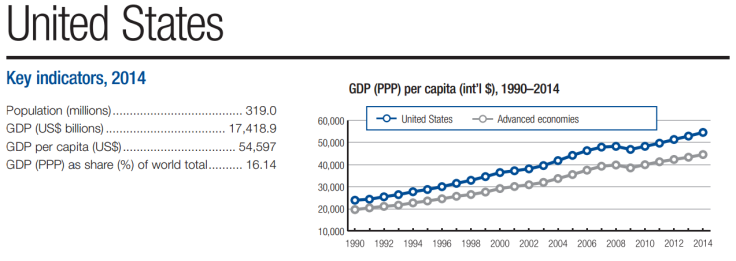Global Competitiveness Report: US Retains Dominance Amid ‘New Normal’ Of Worldwide Economic Unease

To Donald Trump, the American battle for world economic dominance can be summed up neatly: “They’re killing us.” But a closely watched measure of market competitiveness tells a different story.
In an annual report from the World Economic Forum, the U.S. maintained its position as the third most competitive economy as countries jockey to rise out of a sluggish “new normal” defined by flagging productivity and high unemployment.
High levels of innovation and business sophistication gave the American economy a leg-up over competitors like Germany and Japan, ranked fourth and sixth, respectively. The U.S. held onto its third-place ranking from last year, an improvement from 2012’s seventh-place position.

The report, which serves as a reference point for investors worldwide, comes in a year of economic disappointment in emerging markets, whose aggregate growth rate fell from three times that of advanced economies in 2013 to just double in 2015. From China to Brazil, the blistering economic progress of past years has eased as global growth has cooled to its slowest pace since the depths of the global recession in 2009.
Across the world, the wounds of the financial crisis persist. “Almost a decade of economic instability and a double-dip recession have eroded trust in public institutions since 2007 in most advanced economies,” the authors wrote. Infrastructure deteriorated in advanced economies, including the U.S. and Switzerland, and access to capital remained an issue for wide swaths of the developed world.
Switzerland came in at first for the seventh time running, with Singapore second, the report found. Southern Europe, India and Germany all charted significant progress in the rankings.
Though the U.S. scored high on a number of measures related to human capital development -- including the availability of scientists and the ability to retain talent -- some soft spots remain. American math and science education continues to lag behind other advanced economies, ranking at 44 out of 140. Labor-employer relations also fell short of the closest U.S. competitors at 31st place.

The authors, led by Professor Xavier Sala-i-Martín of Columbia University, warned with record-low interest rates soon coming to an end, the U.S. “will have to embark on a range of reforms to ensure that productivity growth picks up,” in addition to getting a handle on health costs.
The competitiveness rankings derive from 12 broad pillars and 114 indicators of structural and institutional strength, from educational quality to labor compensation, financial market access to infrastructure adequacy.
China, the biggest economic story of 2015, ranked 28th for the second year in a row. An aging workforce and rising production costs held the world’s second-largest economy back as it continues to transition out of its role as the world’s factory. “China must now evolve to a model where productivity gains are generated through innovation and demand through domestic consumption,” the report found.
The report follows the inaugural release of the World Economic Forum’s Inclusive Growth and Development Report, which examined the state of inequality alongside growth prospects throughout the world. That report found the U.S. ranked 28th of 30 advanced economies due to “high and rising levels of both poverty and income inequality.”
© Copyright IBTimes 2024. All rights reserved.






















